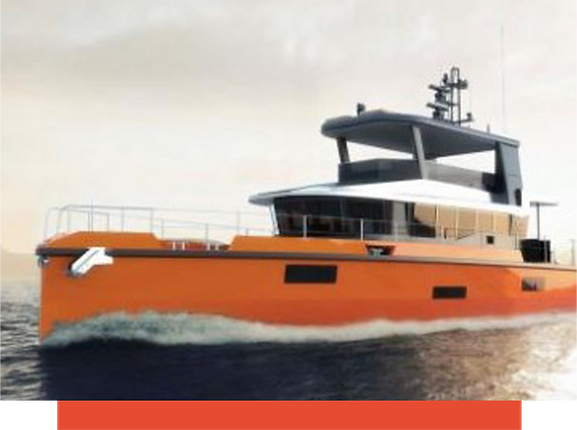40 Essential Tips for Building Your Explorer Yacht
- Chris Leigh-Jones
- Sep 11, 2023
- 4 min read
Updated: Oct 19, 2023
As an explorer yacht builder, I've been a part of many journeys, from the initial sketching of blueprints to the final launch of an explorer yacht. And today, I want to take you behind the scenes of our shipyard and share with you our top 40 tips for building one.
Drawing from my experiences, I hope to guide you through this intricate process of bringing your dream vessel to life, whether you're in the market for ocean yachts for sale or just simply interested in the world of high-latitude sailing.
Our shipyard journey has been a mainly peaceful co-existence. However, as completion nears, it has become obvious that the process is viewed differently from the perspective of the individual parties. (Download the full 40 points in the linked file BELOW.)
Working across language and cultural barriers is an established science. Still, it does involve a deal of introspective thinking if the opportunities are maximized. So, with that in mind and to maybe provide a better understanding to help others contemplate their build, we put pen to paper with a reflection on how this unfolded and what we wished we'd understood before walking in those shoes.
In this reflection, we have used the example of Naval Yachts, not to single them out as I'd wager the name could be easily substituted with any other similar shipyard. The full document can be downloaded here.
How the Process Unfolds - Example
The engineering task can commence once the "Specification" is agreed upon. Some engineering findings will affect other related documents. Open and comprehensive communication on these occasions is paramount. It is tempting to design as you go along, in the field, on the spot. Avoid that temptation and confirm all you can reasonably achieve at an early stage.
Going the "semi-custom" route will considerably help as many potential design options are already field-proven. With 14 LRC/XPM Explorer Yacht designs from Artnautica now completed or in build, plenty of prior experience exists. As an additional fallback, there is also a great history of building the FPB range, and by comparison with our XPM-78, the contemporary FPB 70 is worth studying.
The Design Phase for the XPM Explorer Yacht Range
Stay vigilant to potential side effects or issues that could arise during the design process. Consider alternative solutions in case of significant problems, and be prepared to adjust your course early on. Never make it a battle of wills; there is more than one correct solution. Sometimes, showing flexibility is acceptable, and you will gain more later.
Define minimum acceptable clearances — appliances, corridors, turning circles, door widths, and deck head heights. Do not leave that to chance, or you may not like the result. We have intervened three times to raise a ceiling height or accessway "built on-site." The Antalya tradesmen are, on average, about 100mm / 4" shorter than typical UK/USA males. What is acceptable to one person is not to another. Build this data into the Specification as a design rule.
The Build Phase - Example
Change orders should be minimized to prevent schedule disruptions. They often result in domino effects on the production line. Above a de minimus figure, Change Orders will be implemented once the agreed payment is made. All deviations or additions requested should be documented with Change Orders, including the effect on delivery dates. Change Orders are your friend, providing a documented history. We have had over 70 C/O as the build has progressed; the design was not locked down early on ina. rush to get going. This number reflects our requests and yard responsibilities, so no blame is attached. Sometimes a C/O documents a nil-charge decision; others record owner-instigated deviation or correct yard misinterpretations. Having lived through that pain, the semi-custom option is now more clearly available for the next build, especially the XPM-78 and XPM-85.
Contracts and Project Management - Example
Project progress should be verified, and time remaining documented by both parties. For personal and cultural reasons, there will always be a temptation for the yard to insist all is on time and budget, only to discover later that this is perhaps inaccurate. This was probably our biggest mistake; trust, but "always verify" would have been a better approach. Wishful thinking or group thinking takes over, only to fail at a later date. Cultural differences also play a role here, exemplified by the desire not to upset a client with bad news, eventually resulting in frustration. The time to discuss delays is when there is time to effect remedial action. It is too late to have this conversation after repeatedly missing launch dates.
Final Thoughts
There will be a constant stream of issues toward the end of your build. How to approach those problems greatly affects the journey itself. There are always solutions, whether acceptance, an engineering alteration, or an alternative path. The Owner and the Yard have the same goal: a successful launch. It is best to resist the temptation to blame or otherwise become adversarial.
I'm just saying!
Chris Leigh-Jones
In researching this Blog, I found similar advice from Steve Dashew on Setsail.com, documenting his reflections on building the 18 x FPB vessels. The comments are more extensive than ours, as is his way. See if you can find the parallels!
I also saw this video for Bering Yachts, in the same location as our builder, Naval Yachts. It shows the interaction between an owner and designer discussing the preliminary layout and their wishes or restrictions. We have been in many similar meetings not 300 meters away. There is a video link HERE.


























Comments